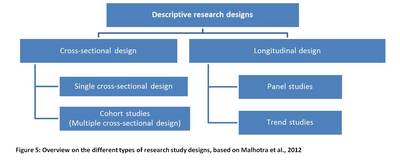D.5 Step 5: Choice of research design
Introduction
Now that you have considered (and hopefully eliminated) potential sources of error during your survey, you should be ready to choose your research design. First, you have decided exactly from whom you want to collect your data, and now you need to define how many times you want to collect your data. Figure D.5-1 shows an overview of the different options (research designs) you have; here, we only present so-called descriptive research designs. One decision you have to take is whether you want to collect data from one specific sample only once (these are called cross-sectional studies), or whether you want to collect data more than one time (which are called longitudinal studies). Longitudinal studies reveal changes that take place over time, e.g. whether the total number of organic goat farms in your country increased, or how the average size of organic farms has developed.
In a single cross-sectional study, data are only collected a single time from one specific sample. In market data collection, this research design is not very common, as you are normally interested in changes and developments. Cohort studies (multiple cross-sectional design) consist of a series of surveys conducted at specific time intervals. The ‘cohort’ is a group of elements who are in the same position or experience the same event at a given time interval (e.g. a regular survey of newly converted organic farmers every five years).
Panel studies are a very important type of longitudinal design for market data collection. Panels are samples of elements, often households or consumers, that have agreed to provide information at certain time intervals over a long period of time, for example once a week over five years. Thus, in panel studies you ask exactly the same people over a longer period of time. In trend studies, the elements from whom you collect your data have the same characteristics (e.g. age group, gender, income), but they are not exactly the same people.
The checklist provides the relevant questions for your choice of the right research design.
Checklist: Which is the right research design for you?
- Which research design have other people used for the same kind of data collection?
- How many times do you want to collect the same kind of data? Only once → Single cross-sectional design
- Do you want to collect data from exactly the same people? If yes → Single cross-sectional study (for collecting data only once) or panel study (for collecting data several times)
- Do you want to collect data from comparable, but not the same people? If yes → Cohort study or trend study
 This website was archived on January 11, 2020 and is no longer updated.
This website was archived on January 11, 2020 and is no longer updated.

